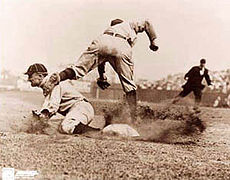
Charles M. Conlon
Encyclopedia

United States
The United States of America is a federal constitutional republic comprising fifty states and a federal district...
photographer. He worked for New York City
New York City
New York is the most populous city in the United States and the center of the New York Metropolitan Area, one of the most populous metropolitan areas in the world. New York exerts a significant impact upon global commerce, finance, media, art, fashion, research, technology, education, and...
newspapers in the early 1900s, as a proof-reader with a photographic hobby before editor John B. Foster invited him to shoot photographs for The Telegram daily newspaper sporting pages and for the Spalding's Base Ball Guide annual.
Charley Conlon took thousands of portraits of major league baseball
Major League Baseball
Major League Baseball is the highest level of professional baseball in the United States and Canada, consisting of teams that play in the National League and the American League...
players. His most famous photo is a fortunate action shot of Ty Cobb
Ty Cobb
Tyrus Raymond "Ty" Cobb , nicknamed "The Georgia Peach," was an American Major League Baseball outfielder. He was born in Narrows, Georgia...
sliding into third base at Hilltop Park
Hilltop Park
Hilltop Park was the nickname of a baseball park that formerly stood in the Washington Heights neighborhood of New York City. It was the home of the New York Yankees Major League Baseball club during 1903-1912 when they were known more often as the "Highlanders"...
in 1909, upending the fielder, Jimmy Austin
Jimmy Austin
James Phillip "Jimmy" Austin was a professional baseball player and coach.-Early years:Austin was born in Swansea, Wales, the son of a shipbuilder. He was one of only three Major League baseball players to be born in Wales...
. Many of his photos of baseball's early stars are instantly recognizable, due to having been reprinted frequently over the years.
Conlon was born in Albany, New York in 1868. He grew up in neighboring Troy and retired there. He died in 1945, predeceased by his wife and having no children or siblings. (Amedio, E8)
Charles Conlons' original glass plate negatives are owned by North Little Rock, Arkansas collector John Rogers. The collection of 8,400 different Conlon glass negatives are housed in the John Rogers Archive www.johnrogersarchive.com. Rogers displayed the Conlon collection at The National Sports Collectors Convention in Baltimore, MD in July 2010.
The Cobb photo
One day in New York, in 1909, Conlon snapped an action photo of Cobb sliding into third base. For publication, the original photo was cropped on the right, taking away almost half of the image. That is the version everyone saw until Baseball's Golden Age: The Photographs of Charles M. Conlon was published in 1993. The excised portion is included and shows more of the right-side bleachers, as well as the left arm of the third base coach.Conlon was actually on the field, a common practice of the day, "behind third base, under the hood of a large, tripod-supported Graflex camera" (Amedio, E1). He was positioned to the outfield side of the third base coach's box, in foul territory. Cobb was on second. New York third baseman Jimmy Austin
Jimmy Austin
James Phillip "Jimmy" Austin was a professional baseball player and coach.-Early years:Austin was born in Swansea, Wales, the son of a shipbuilder. He was one of only three Major League baseball players to be born in Wales...
was playing in for a possible sacrifice bunt. Cobb took off for third, directly toward Conlon, but the batter did not get the bunt down. Austin backpedaled to take the throw from the catcher. Cobb tripped Austin over and the catcher's throw sailed into left field. Presumably Cobb could have gotten up and scored, but the book does not elaborate.(McCabe 2003)
Instead, the issue was whether Conlon got the shot or not. He changed plates, just to be safe, because he did not remember if he had squeezed the shutter bulb or not, and he knew it had potential to be a great shot. It turned out that he had, it was, and baseball had one of its most iconic images.

